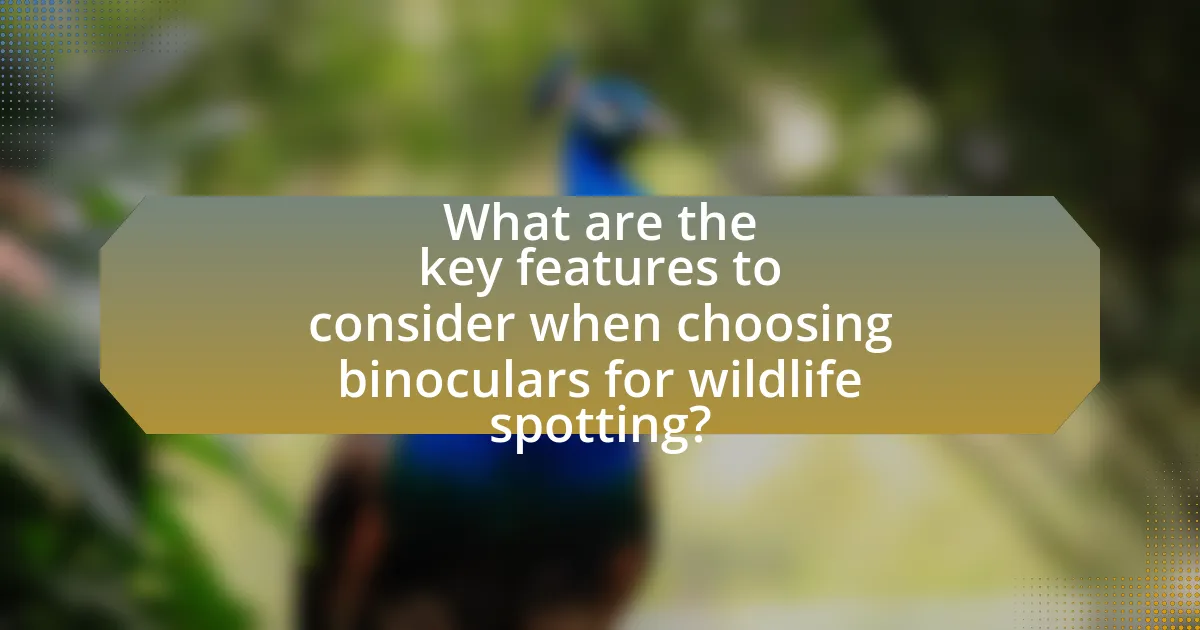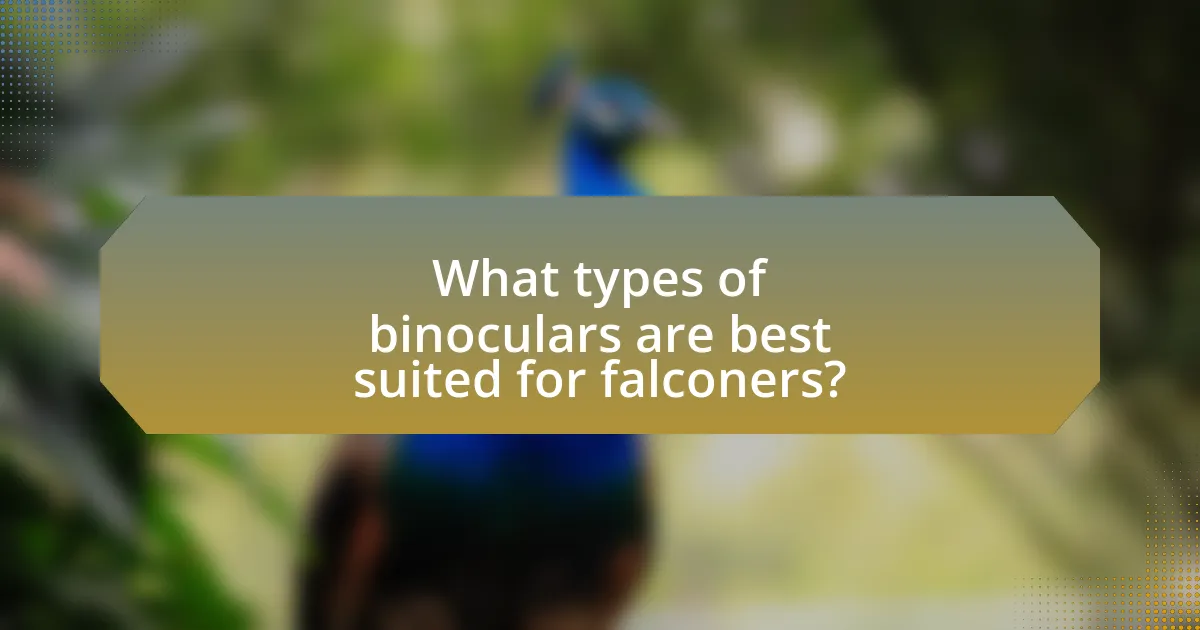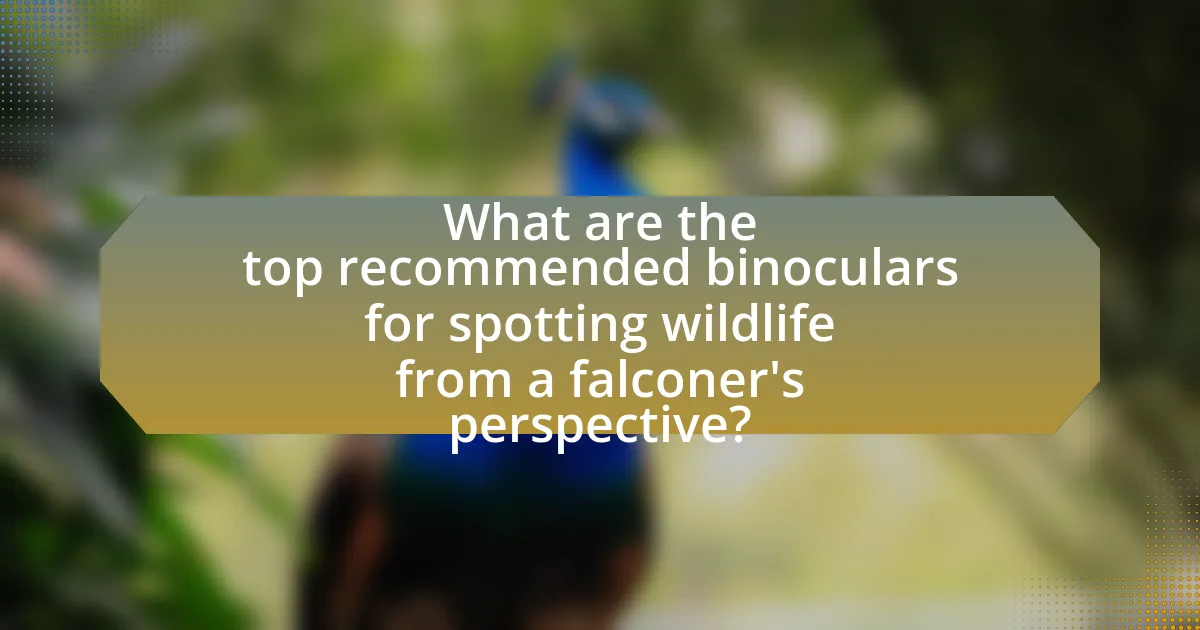The article focuses on selecting the best binoculars for wildlife spotting from a falconer’s perspective, emphasizing key features such as magnification, objective lens diameter, field of view, weight, and waterproofing. It discusses how magnification affects image stability and detail visibility, while the objective lens diameter influences light-gathering ability, crucial for low-light conditions. The importance of a wider field of view for tracking moving animals is highlighted, along with the advantages of roof prism versus porro prism designs. Additionally, the article reviews top recommended models and brands, budget options, and practical tips for effective wildlife observation, ensuring readers gain comprehensive insights into optimizing their binocular selection for wildlife spotting.
What are the key features to consider when choosing binoculars for wildlife spotting?

When choosing binoculars for wildlife spotting, key features to consider include magnification, objective lens diameter, field of view, weight, and waterproofing. Magnification, typically ranging from 8x to 10x, affects how close the subject appears; higher magnification can make it harder to stabilize the image. The objective lens diameter, measured in millimeters, influences light-gathering ability, with larger lenses providing brighter images in low light conditions. A wider field of view allows for easier tracking of moving animals, which is crucial in wildlife observation. Lightweight binoculars enhance portability, making them easier to carry during long outings. Waterproofing ensures durability and functionality in various weather conditions, which is essential for outdoor use. These features collectively enhance the overall experience and effectiveness of wildlife spotting.
How does magnification affect wildlife observation?
Magnification significantly enhances wildlife observation by allowing observers to see distant animals in greater detail. Higher magnification enables clearer identification of species, behaviors, and physical characteristics, which is crucial for accurate wildlife study and enjoyment. For instance, binoculars with 10x magnification provide a closer view of wildlife compared to 8x, making it easier to observe subtle details like plumage patterns or antler configurations. Research indicates that increased magnification can improve the observer’s ability to detect animals in complex environments, as noted in studies on visual acuity and wildlife monitoring techniques.
What is the ideal magnification range for spotting wildlife?
The ideal magnification range for spotting wildlife is typically between 8x and 10x. This range provides a balance between detail and stability, allowing observers to see animals clearly without excessive shaking or loss of field of view. Research indicates that magnifications higher than 10x can lead to difficulties in maintaining a steady image, especially in dynamic environments where wildlife is often found.
How does higher magnification impact image stability?
Higher magnification reduces image stability due to increased sensitivity to movement and vibrations. As magnification increases, even slight hand movements or environmental factors, such as wind, can cause significant shifts in the viewed image, leading to blurriness. This phenomenon is supported by the principle that optical systems with higher magnification require more precise alignment and stabilization to maintain a clear image, as evidenced by the need for image stabilization technology in high-powered binoculars.
What role does objective lens diameter play in performance?
The objective lens diameter significantly influences the performance of binoculars by determining the amount of light that enters the device. A larger objective lens diameter allows more light to be captured, resulting in brighter images, especially in low-light conditions such as dawn or dusk, which are critical for wildlife observation. For instance, binoculars with a 42mm objective lens can gather more light than those with a 32mm lens, enhancing visibility and detail in challenging lighting. This increased light-gathering capability directly impacts the clarity and sharpness of the viewed image, making it essential for effective wildlife spotting.
How does lens diameter influence light gathering ability?
Lens diameter directly influences light gathering ability by determining the amount of light that can enter the optical system. A larger lens diameter allows more light to be collected, enhancing visibility in low-light conditions, which is crucial for activities like wildlife spotting. For instance, binoculars with a lens diameter of 42mm can gather significantly more light than those with a 25mm diameter, resulting in brighter and clearer images. This principle is supported by the formula for light-gathering power, which states that the area of the lens (proportional to the square of the diameter) increases with the square of the diameter, thereby increasing the light captured.
What is the significance of exit pupil size in low light conditions?
The significance of exit pupil size in low light conditions is that a larger exit pupil allows more light to enter the eye, enhancing visibility in dim environments. In low light, such as dawn or dusk, the human pupil can dilate up to 7 mm, so binoculars with an exit pupil size close to this measurement, typically around 5 mm to 7 mm, provide optimal performance. This increased light transmission improves image brightness and clarity, which is crucial for activities like wildlife spotting where detail is essential. Studies indicate that binoculars with a larger exit pupil can significantly improve the user’s ability to discern details in low-light scenarios, making them more effective for observing wildlife during these times.
Why is field of view important for wildlife spotting?
Field of view is crucial for wildlife spotting because it determines how much area can be observed at once, allowing for better tracking of animals in their natural habitat. A wider field of view enables spotters to quickly locate and follow moving wildlife, which is essential in environments where animals may be elusive or camouflaged. Research indicates that binoculars with a field of view of 300 feet at 1,000 yards or more significantly enhance the spotting experience, as they provide a broader perspective and reduce the need for constant adjustments. This capability is particularly beneficial in dense forests or open landscapes where animals may appear suddenly.
How does a wider field of view enhance the spotting experience?
A wider field of view enhances the spotting experience by allowing users to see more of the environment at once, which is crucial for tracking moving wildlife. This broader perspective enables quicker identification of animals and their behaviors, as users can scan larger areas without needing to adjust their binoculars frequently. Research indicates that binoculars with a field of view of 400 feet at 1,000 yards can significantly improve the chances of spotting elusive species, as they provide a more comprehensive view of the surroundings, facilitating better situational awareness and reducing the likelihood of missing important details.
What are the trade-offs between field of view and magnification?
The trade-offs between field of view and magnification are significant in optical devices like binoculars. Increasing magnification narrows the field of view, making it harder to track moving subjects, while a wider field of view allows for easier tracking but at lower magnification levels. For instance, binoculars with 10x magnification typically have a narrower field of view compared to those with 7x magnification, which can be crucial for spotting wildlife effectively. This relationship is essential for falconers, as they need to balance the ability to see details of distant birds with the necessity of tracking their movements in a broader context.
What types of binoculars are best suited for falconers?

The best types of binoculars for falconers are those with high magnification and wide field of view, typically ranging from 8x to 10x magnification. These specifications allow falconers to observe birds in detail while maintaining a broad perspective of their surroundings. Additionally, binoculars with a durable, weather-resistant design are essential for outdoor use, ensuring reliability in various conditions. The combination of these features enhances the falconer’s ability to track and identify birds effectively, making them crucial tools in the field.
What are the advantages of roof prism versus porro prism binoculars?
Roof prism binoculars offer a more compact and lightweight design compared to porro prism binoculars, making them easier to handle and carry, especially during extended outdoor activities like wildlife spotting. The roof prism configuration allows for a straight-line optical path, which results in a slimmer profile and improved portability. Additionally, roof prism binoculars typically provide better waterproofing and fog-proofing features, enhancing their durability in various weather conditions. These advantages make roof prism binoculars a preferred choice for many wildlife enthusiasts and falconers who require reliable and convenient optics in the field.
How do roof prism designs benefit portability and durability?
Roof prism designs enhance portability and durability by allowing binoculars to be more compact and lightweight. This design minimizes the overall size of the binoculars while maintaining optical performance, making them easier to carry during outdoor activities such as wildlife spotting. Additionally, roof prism binoculars typically feature a more robust construction, often utilizing materials like rubber armor and high-quality plastics, which provide better shock resistance and weatherproofing. These features contribute to their longevity and reliability in various environmental conditions, ensuring that they can withstand the rigors of outdoor use.
What are the specific benefits of porro prism designs for wildlife spotting?
Porro prism designs offer several specific benefits for wildlife spotting, primarily enhanced depth perception and a wider field of view. These binoculars utilize a zigzag light path, which allows for a more compact design while maintaining a larger objective lens diameter. This configuration results in brighter images and improved clarity, essential for observing wildlife in varying light conditions. Additionally, the design typically provides a more comfortable grip and better ergonomics, making prolonged use easier for wildlife enthusiasts. The combination of these features makes porro prism binoculars particularly effective for spotting animals in their natural habitats.
How do specialized features enhance binocular performance for falconers?
Specialized features enhance binocular performance for falconers by providing superior optical clarity, lightweight design, and enhanced durability. These features, such as high-quality lenses and coatings, improve light transmission and reduce glare, allowing falconers to spot and track birds more effectively in various lighting conditions. Additionally, ergonomic designs and waterproof or fog-proof construction ensure that binoculars remain functional in diverse environments, which is crucial for falconers who often operate in the field. The combination of these specialized features results in improved visual acuity and comfort, ultimately aiding falconers in their pursuit of wildlife observation and bird training.
What is the importance of waterproof and fog-proof construction?
Waterproof and fog-proof construction is crucial for binoculars used in wildlife spotting because it ensures durability and optimal performance in various environmental conditions. This construction prevents moisture from entering the binoculars, which can cause internal fogging and damage to optical components. For instance, binoculars designed for outdoor use often feature O-ring seals and nitrogen purging to maintain clarity and functionality in humid or rainy conditions. Such features enhance the user experience by providing clear, unobstructed views, which is essential for spotting wildlife effectively.
How do coatings on lenses affect image quality?
Coatings on lenses significantly enhance image quality by reducing glare, improving light transmission, and minimizing reflections. These coatings, such as anti-reflective and multi-coatings, allow more light to pass through the lens, which results in brighter and clearer images. For instance, anti-reflective coatings can increase light transmission by up to 99%, thereby enhancing contrast and color fidelity in the viewed image. Additionally, coatings help to reduce lens flare and ghosting, which can distort the image, especially in bright conditions. This improvement in image quality is crucial for activities like wildlife spotting, where clarity and detail are essential for effective observation.
What are the top recommended binoculars for spotting wildlife from a falconer’s perspective?

The top recommended binoculars for spotting wildlife from a falconer’s perspective are the Swarovski EL 10×42 and the Zeiss Victory SF 10×42. These models are favored for their exceptional optical clarity, wide field of view, and lightweight design, which are crucial for tracking fast-moving birds and other wildlife. The Swarovski EL features high-quality glass and advanced coatings that enhance light transmission, making it ideal for low-light conditions often encountered in falconry. Similarly, the Zeiss Victory SF offers superior ergonomics and a comfortable grip, allowing for extended use without fatigue, which is essential for falconers who spend long hours observing. Both binoculars are highly rated by wildlife enthusiasts and professionals for their durability and performance in the field.
Which brands are known for producing high-quality wildlife binoculars?
Brands known for producing high-quality wildlife binoculars include Swarovski, Zeiss, Leica, and Nikon. These brands are recognized for their superior optical performance, durability, and advanced features tailored for wildlife observation. For instance, Swarovski’s EL series is renowned for its exceptional clarity and brightness, while Zeiss offers the Victory SF line, which is praised for its wide field of view and ergonomic design. Leica’s Ultravid models are celebrated for their compactness and robust construction, and Nikon’s Monarch series provides excellent value with high-quality optics and waterproof designs.
What specific models are favored by experienced falconers?
Experienced falconers favor specific binocular models such as the Swarovski EL, Zeiss Victory SF, and Leica Ultravid. These models are preferred due to their superior optical quality, durability, and ergonomic design, which enhance the birdwatching experience. For instance, the Swarovski EL offers exceptional clarity and brightness, while the Zeiss Victory SF is known for its wide field of view and lightweight construction. The Leica Ultravid is recognized for its compact size and robust build, making it ideal for outdoor use. These features collectively support the needs of falconers in spotting and tracking wildlife effectively.
How do user reviews and expert opinions compare for these models?
User reviews and expert opinions for the binocular models often align in highlighting key features, but they can differ in emphasis. Users typically focus on practical aspects such as ease of use, comfort during extended viewing, and real-world performance in various lighting conditions. In contrast, experts tend to evaluate optical quality, build materials, and technical specifications more rigorously. For instance, while users may praise a model for its lightweight design and portability, experts might critique it for lower optical clarity compared to higher-end models. This divergence illustrates that user reviews are often more subjective and experience-based, whereas expert opinions provide a more analytical and technical assessment of the models.
What budget options are available without compromising quality?
Quality binoculars can be found at budget-friendly prices, with options like the Vortex Diamondback 8×42 and the Nikon Prostaff 3S 8×42. These models provide excellent optical performance, durability, and user-friendly features, making them suitable for wildlife spotting. The Vortex Diamondback offers a wide field of view and a robust build, while the Nikon Prostaff is known for its clarity and lightweight design. Both options are well-reviewed by users and experts, confirming their value without sacrificing quality.
How can one find the best value binoculars for wildlife spotting?
To find the best value binoculars for wildlife spotting, one should prioritize key features such as magnification, objective lens diameter, and optical quality. Magnification typically ranges from 8x to 10x for wildlife observation, providing a balance between detail and stability. An objective lens diameter of 42mm is often ideal, allowing for sufficient light gathering in various conditions. Additionally, look for binoculars with multi-coated lenses to enhance clarity and brightness.
Research indicates that reputable brands like Nikon, Vortex, and Zeiss offer models that combine these features at competitive prices, ensuring good value. For instance, the Nikon Prostaff 3S 8×42 binoculars are frequently recommended for their performance-to-price ratio, providing excellent optical quality without a premium cost.
What features should be prioritized in budget binoculars?
In budget binoculars, the features that should be prioritized include optical quality, magnification, field of view, and durability. Optical quality is essential for clear and bright images, which is crucial for wildlife observation; lenses with multi-coating enhance light transmission and reduce glare. Magnification typically ranges from 8x to 10x, providing a good balance between detail and stability. A wider field of view allows users to track moving animals more easily, which is important in wildlife spotting. Lastly, durability, including water and fog resistance, ensures that the binoculars can withstand outdoor conditions, making them reliable for field use. These features collectively enhance the user experience and effectiveness in wildlife observation.
What practical tips should falconers consider when using binoculars for wildlife spotting?
Falconers should consider using binoculars with a wide field of view for effective wildlife spotting. A wide field of view allows falconers to track moving animals more easily and spot them in their natural habitat. Additionally, selecting binoculars with a magnification of 8x to 10x strikes a balance between detail and stability, reducing image shake. Opting for lightweight and compact models enhances portability, making it easier to carry during long outings. Finally, choosing binoculars with good light transmission and anti-reflective coatings improves visibility in various lighting conditions, which is crucial for spotting wildlife at dawn or dusk.
How can one effectively stabilize binoculars for clearer viewing?
To effectively stabilize binoculars for clearer viewing, one should use a tripod or a stabilizing harness. A tripod provides a solid base, reducing hand movement and vibrations, which is crucial for maintaining a steady image, especially at higher magnifications. Additionally, a stabilizing harness distributes the weight of the binoculars across the body, allowing for more comfortable and stable viewing over extended periods. Studies show that using a tripod can improve image stability by up to 50%, significantly enhancing the clarity of distant subjects.
What techniques can enhance the overall wildlife observation experience?
Techniques that can enhance the overall wildlife observation experience include using high-quality binoculars, practicing patience, and understanding animal behavior. High-quality binoculars provide clear and magnified views, allowing observers to see details from a distance, which is crucial for identifying species and behaviors. Patience is essential, as wildlife often requires time to appear and acclimate to human presence; remaining still and quiet increases the chances of sightings. Understanding animal behavior, such as feeding patterns and migration habits, allows observers to anticipate where and when to look for specific wildlife, improving the likelihood of successful observations.


